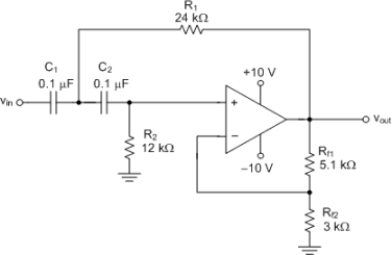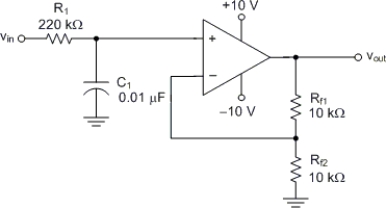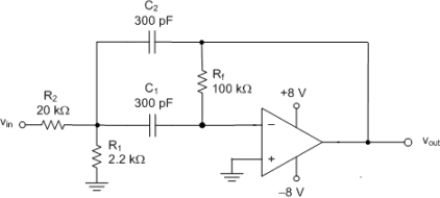Deck 17: Tuned Amplifiers
Question
Question
Question
Question
Question
Question
Question
Question
Question
Question
Question
Question
Question
Question
Question
Question
Question
Question
Question
Question
Question
Question
Question
Question
Question
Question
Question
Question
Question
Question
Question
Question
Question
Question

Unlock Deck
Sign up to unlock the cards in this deck!
Unlock Deck
Unlock Deck
1/34
Play
Full screen (f)
Deck 17: Tuned Amplifiers
1
The voltage gain of a practical tuned amplifier is reduced to when operated at either cutoff frequency.
A) 0 dB
B) 3 dB
C) - ∞ dB zero)
D) Av mid) - 3 dB
A) 0 dB
B) 3 dB
C) - ∞ dB zero)
D) Av mid) - 3 dB
Av mid) - 3 dB
2

The circuit in Figure is a
A) multiple feedback bandpass filter.
B) multiple feedback notch filter.
C) Sallen-Key low-pass filter.
D) Sallen-Key high-pass filter.
Sallen-Key high-pass filter.
3

The circuit in Figure is a
A) one-pole low-pass filter.
B) two-pole low-pass filter.
C) one-pole high-pass filter.
D) two-pole high-pass filter.
one-pole low-pass filter.
4
Which type of filter response provides the highest fidelity?
A) Butterworth
B) Chebyshev
C) Bessel
A) Butterworth
B) Chebyshev
C) Bessel

Unlock Deck
Unlock for access to all 34 flashcards in this deck.
Unlock Deck
k this deck
5

The cutoff frequency for the circuit in Figure is approximately
A) 3 Hz.
B) 72 Hz.
C) 455 Hz.
D) 723 Hz.

Unlock Deck
Unlock for access to all 34 flashcards in this deck.
Unlock Deck
k this deck
6
Butterworth active filters are generally preferred over Chebyshev active filters because
A) Butterworth filters are easier to construct.
B) Butterworth filters have higher roll-off rates.
C) the midband gain of the Chebyshev filter is inconsistent.
D) Chebyshev filters have higher roll-off rates.
A) Butterworth filters are easier to construct.
B) Butterworth filters have higher roll-off rates.
C) the midband gain of the Chebyshev filter is inconsistent.
D) Chebyshev filters have higher roll-off rates.

Unlock Deck
Unlock for access to all 34 flashcards in this deck.
Unlock Deck
k this deck
7
A bandpass filter has values of f0 = 1.5 MHz and BW = 100 kHz. What is the value of fC2 for the circuit?
A) 1.6 MHz
B) 1.55 MHz
C) 1.45 MHz
D) 1.4 MHz
A) 1.6 MHz
B) 1.55 MHz
C) 1.45 MHz
D) 1.4 MHz

Unlock Deck
Unlock for access to all 34 flashcards in this deck.
Unlock Deck
k this deck
8

The cutoff frequency for the circuit in Figure is approximately
A) 66 Hz.
B) 94 Hz.
C) 133 Hz.
D) 188 Hz.

Unlock Deck
Unlock for access to all 34 flashcards in this deck.
Unlock Deck
k this deck
9
A low-pass Sallen-Key two-pole) filter has an upper cutoff frequency of 2 kHz and a Butterworth response curve. The voltage gain of the circuit decreases by approximately if its input frequency increases to 200 kHz.
A) 20 dB
B) 40 dB
C) 60 dB
D) 80 dB
A) 20 dB
B) 40 dB
C) 60 dB
D) 80 dB

Unlock Deck
Unlock for access to all 34 flashcards in this deck.
Unlock Deck
k this deck
10

The closed-loop gain of the circuit in Figure is
A) 0 dB.
B) 6 dB.
C) 10 dB.
D) 26 dB.

Unlock Deck
Unlock for access to all 34 flashcards in this deck.
Unlock Deck
k this deck
11

The center frequency of the circuit in Figure is approximately
A) 38 kHz.
B) 78 kHz.
C) 119 kHz.
D) 241 kHz.

Unlock Deck
Unlock for access to all 34 flashcards in this deck.
Unlock Deck
k this deck
12
The frequency ranges) outside of the bandwidth of a given tuned amplifier is referred to as the
A) pass band.
B) stop band.
C) drop band.
D) standard band.
A) pass band.
B) stop band.
C) drop band.
D) standard band.

Unlock Deck
Unlock for access to all 34 flashcards in this deck.
Unlock Deck
k this deck
13

The circuit in Figure is a
A) Sallen-Key low-pass filter.
B) Sallen-Key high-pass filter.
C) multiple-feedback bandpass filter.
D) multiple-feedback notch filter.

Unlock Deck
Unlock for access to all 34 flashcards in this deck.
Unlock Deck
k this deck
14
Two amplifiers are operated at the same center frequency f0). Which of the following statements is true?
A) The amplifier with the higher roll-off rate has the wider bandwidth.
B) The amplifier with the lower roll-off rate has the wider bandwidth.
C) The bandwidth of each circuit is not related of its roll-off rate.
D) The bandwidth of each circuit equals the product of its voltage gain and roll -off rate.
A) The amplifier with the higher roll-off rate has the wider bandwidth.
B) The amplifier with the lower roll-off rate has the wider bandwidth.
C) The bandwidth of each circuit is not related of its roll-off rate.
D) The bandwidth of each circuit equals the product of its voltage gain and roll -off rate.

Unlock Deck
Unlock for access to all 34 flashcards in this deck.
Unlock Deck
k this deck
15
A tuned amplifier has values of f0 = 1.3 MHz and Q = 54. What is the bandwidth of the circuit?
A) 24 kHz
B) 70.2 MHz
C) 54 kHz
D) None of these answers are correct.
A) 24 kHz
B) 70.2 MHz
C) 54 kHz
D) None of these answers are correct.

Unlock Deck
Unlock for access to all 34 flashcards in this deck.
Unlock Deck
k this deck
16
In most applications, tuned amplifiers are designed to have
A) the smallest possible bandwidth.
B) the largest possible bandwidth.
C) a specific bandwidth.
D) an unspecified bandwidth.
A) the smallest possible bandwidth.
B) the largest possible bandwidth.
C) a specific bandwidth.
D) an unspecified bandwidth.

Unlock Deck
Unlock for access to all 34 flashcards in this deck.
Unlock Deck
k this deck
17

The filter in Figure has a response curve.
A) Chebyshev
B) Butterworth
C) Bessel
D) band-stop

Unlock Deck
Unlock for access to all 34 flashcards in this deck.
Unlock Deck
k this deck
18
The voltage gain of an ideal tuned amplifier is reduced to when operated at either cutoff frequency.
A) 0 dB
B) 3 dB
C) - ∞ dB zero)
D) Avmid) - 3 dB
A) 0 dB
B) 3 dB
C) - ∞ dB zero)
D) Avmid) - 3 dB

Unlock Deck
Unlock for access to all 34 flashcards in this deck.
Unlock Deck
k this deck
19

The closed loop gain of the circuit in Figure is
A) 12 dB.
B) 4 dB.
C) 1.3 dB.
D) 0 dB.

Unlock Deck
Unlock for access to all 34 flashcards in this deck.
Unlock Deck
k this deck
20
A tuned amplifier has values of f0 = 455 kHz and BW = 5 kHz. What is the value of Q for the circuit?
A) 450
B) 2275
C) 5
D) 91
A) 450
B) 2275
C) 5
D) 91

Unlock Deck
Unlock for access to all 34 flashcards in this deck.
Unlock Deck
k this deck
21
A class C amplifier is biased
A) at cutoff.
B) at saturation.
C) deeply into cutoff.
D) deeply into saturation.
A) at cutoff.
B) at saturation.
C) deeply into cutoff.
D) deeply into saturation.

Unlock Deck
Unlock for access to all 34 flashcards in this deck.
Unlock Deck
k this deck
22
A tuned amplifier has the following values: Rw = 50 Ω, XL = 1 kΩ, RL = 10 kΩ and f0 = 1200 Hz. What is the circuit bandwidth?
A) 60 Hz
B) 180 Hz
C) 360 Hz
D) 500 Hz
Chapter 17 Tuned Amplifiers Answer Key
A) 60 Hz
B) 180 Hz
C) 360 Hz
D) 500 Hz
Chapter 17 Tuned Amplifiers Answer Key

Unlock Deck
Unlock for access to all 34 flashcards in this deck.
Unlock Deck
k this deck
23
The operation of a class C amplifier is based on the
A) LC effect.
B) flywheel effect.
C) Miller effect.
D) class C effect.
A) LC effect.
B) flywheel effect.
C) Miller effect.
D) class C effect.

Unlock Deck
Unlock for access to all 34 flashcards in this deck.
Unlock Deck
k this deck
24
A tuned amplifier has the following values: Rw = 50 Ω, XL = 1 kΩ, and f0 = 1200 Hz. Assuming the load resistance is infinite, what is the circuit bandwidth?
A) 20 Hz
B) 40 Hz
C) 60 Hz
D) 200 Hz
A) 20 Hz
B) 40 Hz
C) 60 Hz
D) 200 Hz

Unlock Deck
Unlock for access to all 34 flashcards in this deck.
Unlock Deck
k this deck
25
A tuned amplifier has the following values: Rw = 50 Ω, XL = 1 kΩ, and RL = 10 kΩ. What is the quality Q) of the circuit?
A) 6.66
B) 20
C) 50
D) 100
A) 6.66
B) 20
C) 50
D) 100

Unlock Deck
Unlock for access to all 34 flashcards in this deck.
Unlock Deck
k this deck
26
A tuned amplifier has the following values: f0 = 800 kHz and Q = 1.5. What is the value of fC1 for the circuit?
A) 310 kHz
B) 534 kHz
C) 577 kHz
D) Cannot be determined from the information given.
A) 310 kHz
B) 534 kHz
C) 577 kHz
D) Cannot be determined from the information given.

Unlock Deck
Unlock for access to all 34 flashcards in this deck.
Unlock Deck
k this deck
27
A class C amplifier is being designed to accept a +5 Vpk input. What biasing voltage should be applied to the base of the transistor?
A) -5 V
B) -4 V
C) -3 V
D) +4 V
A) -5 V
B) -4 V
C) -3 V
D) +4 V

Unlock Deck
Unlock for access to all 34 flashcards in this deck.
Unlock Deck
k this deck
28
The cutoff frequencies for the filter in Figure are approximately
A) 27.4 kHz and 48.6 kHz.
B) 85.9 kHz and 152.1 kHz.
C) 32.7 kHz and 43.3 kHz.
D) 38 kHz and 119 kHz.
A) 27.4 kHz and 48.6 kHz.
B) 85.9 kHz and 152.1 kHz.
C) 32.7 kHz and 43.3 kHz.
D) 38 kHz and 119 kHz.

Unlock Deck
Unlock for access to all 34 flashcards in this deck.
Unlock Deck
k this deck
29
A tuned amplifier has the following values: Rw = 50 Ω, XL = 1 kΩ, and RL = 10 kΩ. What is the equivalent parallel resistance for Rw?
A) 50Ω
B) 10 kΩ
C) Q = 20
D) 20 kΩ
A) 50Ω
B) 10 kΩ
C) Q = 20
D) 20 kΩ

Unlock Deck
Unlock for access to all 34 flashcards in this deck.
Unlock Deck
k this deck
30
A class C amplifier can be used to produce
A) a dc output.
B) a triangular waveform.
C) harmonics of the input frequency.
D) All of the above.
A) a dc output.
B) a triangular waveform.
C) harmonics of the input frequency.
D) All of the above.

Unlock Deck
Unlock for access to all 34 flashcards in this deck.
Unlock Deck
k this deck
31
The Q of the filter in Figure is approximately
A) 11.2.
B) 3.6.
C) 0.72.
D) 5.
A) 11.2.
B) 3.6.
C) 0.72.
D) 5.

Unlock Deck
Unlock for access to all 34 flashcards in this deck.
Unlock Deck
k this deck
32
The transistor in a Class C amplifier will conduct for .
A) less than 180°
B) more than 180° but less than 360°
C) 360°
D) 0° since it is biased at cutoff
A) less than 180°
B) more than 180° but less than 360°
C) 360°
D) 0° since it is biased at cutoff

Unlock Deck
Unlock for access to all 34 flashcards in this deck.
Unlock Deck
k this deck
33
A discrete tuned amplifier has the following values: L = 10 mH, RW = 3 Ω, and C = 0.1 μF. What is the value of f0 for the amplifier?
A) 15.9 MHz
B) 1.59 kHz
C) 3.18 kHz
D) 5.03 kHz
A) 15.9 MHz
B) 1.59 kHz
C) 3.18 kHz
D) 5.03 kHz

Unlock Deck
Unlock for access to all 34 flashcards in this deck.
Unlock Deck
k this deck
34
A parallel LC circuit has the following values: fr = 424 Hz, L = 5 mH, and Rw = 4 Ω. What is the Q of the circuit?
A) 3.33
B) 3.33 × 10-3
C) 0.333
D) 33.3
A) 3.33
B) 3.33 × 10-3
C) 0.333
D) 33.3

Unlock Deck
Unlock for access to all 34 flashcards in this deck.
Unlock Deck
k this deck



